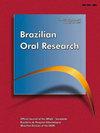Social capital and possible bruxism during the COVID-19 pandemic among Brazilian undergraduates
IF 2.5
4区 医学
Q2 Dentistry
引用次数: 0
Abstract
This study investigated the prevalence of possible bruxism and its association with social capital among undergraduates during the coronavirus disease (COVID-19) pandemic. This cross-sectional study was conducted at a private university in Southern Brazil. Data were collected through a self-administered electronic questionnaire (Google Forms). Possible bruxism was measured using the following question: “Do you grind your teeth or clench your jaws?”. Social capital was evaluated using individual social networks. Data on self-perceived oral health, anxiety, sociodemographics, and information related to university graduates were also collected. Adjusted logistic regression models with a hierarchical approach were used to evaluate associations. The results are presented as odds ratios (ORs) and 95% confidence intervals (95%CIs). Altogether, 345 undergraduates participated in the study, with a mean age of 21.8 years (standard deviation = 5.21). The prevalence of bruxism in the sample was 57.1%. Undergraduates with low social capital had 2.06 times greater odds of bruxism than their counterparts (OR 2.06; 95%CI 1.11–3.83). Female undergraduates (OR 2.40, 95%CI 1.39–4.12), those who were in the final year of university (OR 1.13, 95%CI 1.04–1.21), and those who perceived they needed dental treatment (OR 1.91; CI: 1.21–3.02) also had greater odds of possible bruxism. In conclusion, the prevalence of possible bruxism was high among undergraduate students during the COVID-19 pandemic and associated with lower social capital levels. Knowledge of these factors is important to identify risk groups and plan strategies to control bruxism in this population.巴西大学生COVID-19大流行期间的社会资本和可能的磨牙症
本研究旨在调查2019冠状病毒病(COVID-19)大流行期间大学生可能的磨牙患病率及其与社会资本的关系。这项横断面研究是在巴西南部的一所私立大学进行的。数据通过自我管理的电子问卷(谷歌表格)收集。可能的磨牙症是通过以下问题来衡量的:“你是磨牙还是咬牙?”社会资本是用个人社会网络来评估的。自我感知口腔健康、焦虑、社会人口统计数据以及与大学毕业生相关的信息也被收集。采用分层方法调整逻辑回归模型来评估关联。结果以比值比(ORs)和95%置信区间(95% ci)表示。共有345名大学生参与研究,平均年龄21.8岁(标准差= 5.21)。样本中磨牙的患病率为57.1%。社会资本低的大学生患磨牙症的几率是同龄大学生的2.06倍(OR 2.06;95%可信区间1.11 - -3.83)。女性本科生(OR 2.40, 95%CI 1.39-4.12)、大学最后一年的学生(OR 1.13, 95%CI 1.04-1.21)和认为自己需要牙科治疗的学生(OR 1.91;CI: 1.21-3.02)也有更大的可能的磨牙。综上所述,在2019冠状病毒病大流行期间,本科生中可能的磨牙患病率较高,且与较低的社会资本水平相关。了解这些因素对于识别危险人群和制定控制磨牙症的策略是很重要的。
本文章由计算机程序翻译,如有差异,请以英文原文为准。
求助全文
约1分钟内获得全文
求助全文
来源期刊

Brazilian Oral Research
DENTISTRY, ORAL SURGERY & MEDICINE-
CiteScore
3.70
自引率
4.00%
发文量
107
审稿时长
12 weeks
 求助内容:
求助内容: 应助结果提醒方式:
应助结果提醒方式:


